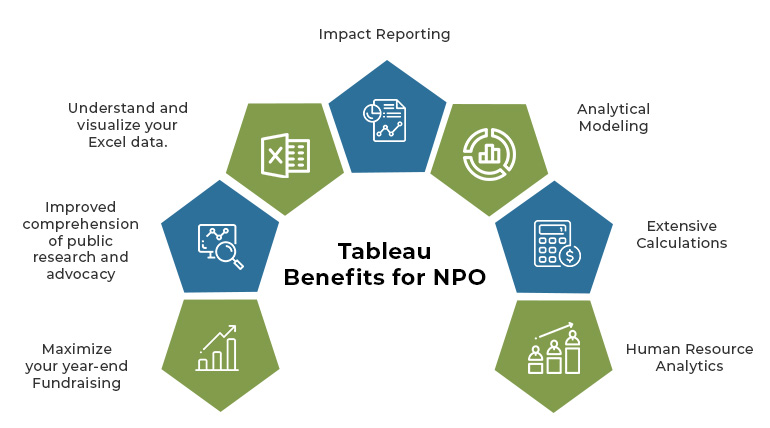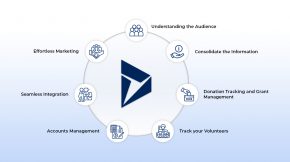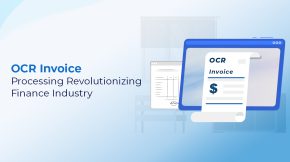7 Ways Tableau Can Benefit Your NPO
If you’re reading this blog, you probably need to decide if you should spend your own money on Tableau or your business’s money.
For data visualization, several tools make the pictures look very simple. Tableau is one of the tools for visualizing data that has grown the fastest, and it is now quite popular in the business intelligence (BI) sector. Using this program is the best way to change or convert raw data into a format that is easy to understand.
About Tableau
Tableau is a powerful data visualization program that data analysts can use, scientists, statisticians, and other professionals to show the data and conclusions based on the data analysis. Tableau is well-known because it can quickly process the data you put in and show you what you need to see. In short tableau benefits may turn your data into insights you can use to guide your next action. Tableau can do all this while ensuring the highest level of security and promising to fix security flaws as soon as users find them or as they become known.
Tableau for Nonprofits
Using data more intelligently can positively impact any organization, whether a large nonprofit relies on significant donations or a small one where no donation is too small. Your entire organization can succeed with Tableau’s assistance if you want to uncover insights into your donor data.
Nonprofit organizations may utilize Tableau Analytics software to analyze their data better and increase their bottom line.
With its aid, they may raise more money, plan events and campaigns that are more successful, and discover ways to make a bigger influence on the world.
Tableau Benefits for Nonprofits

Large and small non-profit organizations can use Tableau to understand the data behind contributions better.
It may assist you in discovering insights into your donor data that will enable you to improve your fundraising efforts.
There are many Tableau Benefits for NPO that can help your NPO organization, and these are as follows: –
- Maximize your year-end Fundraising
The end of the year is the most critical time for every nonprofit organization. This is often when their annual income rises by 20–50%. So, nonprofits can use information about past years, specific donations, historical events, etc., to make their fundraising efforts more effective. They may have a better idea of how to persuade donors, which could help them make more money. The graphic data lets nonprofits figure out which donors are most likely to give based on factors like zip code, gender, income, etc. At the end of the year, nonprofits are stressed, so this data benefits them.
- Improved comprehension of public research and advocacy
You can use Tableau data to make a compelling story that helps non-profits persuade policymakers and ensures the general public remembers what they are trying to say. This is very important when trying to get people to take responsibility, teach them about complex topics, or make them aware of public issues.
- Impact Reporting
So, to keep funders interested, nonprofits must show their work and what happens. The problem with this is that making reports could cost your company a lot of money and take a lot of time. This is where Tableau comes in handy because it makes it easy to use your data to tell a story and show the world how important your work is. It cuts down on time it takes to make the report you want.
- Understand and visualize your Excel data.
Excel is a program often used by non-profits to store, analyze, and calculate data. It takes this to a new level by letting Tableau use visual analytics and new ways to interact with and analyze data.
- Analytical Modeling
Nonprofits can use Tableau’s robust out-of-the-box statistics and prediction tools to code hypotheses and find hidden variables. For example, organizations can use their modeling capabilities to get data on trends and predictions. They can now add a trend line or data about the future to any chart. Then, you can look at click information with a simple right-click. Using drag-and-drop, you can model different ways to group and compare data. The good news is that these predictive metrics are easy to separate and are fully built into the front end. Not only that, but by combining this front-end data with strong input capabilities, you can quickly change computations and test other situations.
- Extensive Calculations
With Tableau’s powerful calculation language, you can handle complex data with simple expressions and add any calculation to your analysis. You can use calculated fields to show logic based on conditions, run special operations, and do the math on specific data types. Expressions for the Level of Detail (LOD) and table calculations are two important tools that make complex analysis possible. Tableau has a lot of time-series analysis built-in because a lot of the data in the world can be shown as time series. You can take samples of your data, look into seasonality, and do other common time-series tasks with the help of a powerful user interface.
- Human Resource Analytics
Every non-profit requires employees to run its operations and carry out its initiatives. All of these individuals must be effectively handled for your efforts to succeed. The greatest personnel can be hired, retained, and invested in with HR analytics, allowing you to use your human resources efficiently. To find out more about your team’s effectiveness, you may view your statistics. To improve their performance, you can examine their hours and how they handled specific tasks.
How Beyond Key can assist you to reach your NPO goals with Tableau Benefits.
Nonprofits and charities hire people who are very passionate about their missions and committed to their success and loyalty. To interact with technology, you must pay attention to and take advantage of certain things. Beyond Key is a good partner because we know what nonprofits need and how to help them.
Getting information about how your nonprofit organization is doing can take much less time and work if you use the Tableau dashboards from Beyond Key.
With the help of Tableau Benefits you can use informative reports and visualizations, the people who work for or volunteer for your NPO can focus more on the mission and less on tedious administrative tasks like updating weekly reports or managing complicated and large spreadsheets.
Tableau may also help you improve your brand and message by giving you quick insights into how your audience sees your organization. It’s essential to get this feedback and use it since your company’s social media accounts give you a unique chance to talk directly with your audience.
It shows you what is working and what isn’t, so you can change your NPO plan immediately to get the most out of your time and money.
You can use Beyond Key’s Tableau Analytics to learn more about the data behind past and present events so you can make better events in the future.
Conclusion
Tableau Analytics could be beneficial to any nonprofit organization. With its help, you might learn more about how your donors act and how to improve your fundraising.
The data will also help you figure out how to make the most of your end-of-year marketing so you can improve your activities that bring in money and reach your goals. With the help of Tableau, you can also understand the facts behind events and how each one helps your organization reach its goals. Tableau benefits can also help you make impact reports to show your stakeholders that your work is important and making a difference.
You will also be able to combine data from Tableau and other sources and see and understand your Excel data better. Using Tableau, you can learn how to manage your human resources better and do complex calculations. If you want to use Tableau analytics for your organization, whether a nonprofit or a for-profit business, Beyond Key has become very good at making custom visualizations that fit the needs of your business.
We can help you to chalk out your journey to successful Tableau implementation with our Tableau consulting services. Simply write back to us to learn more.













